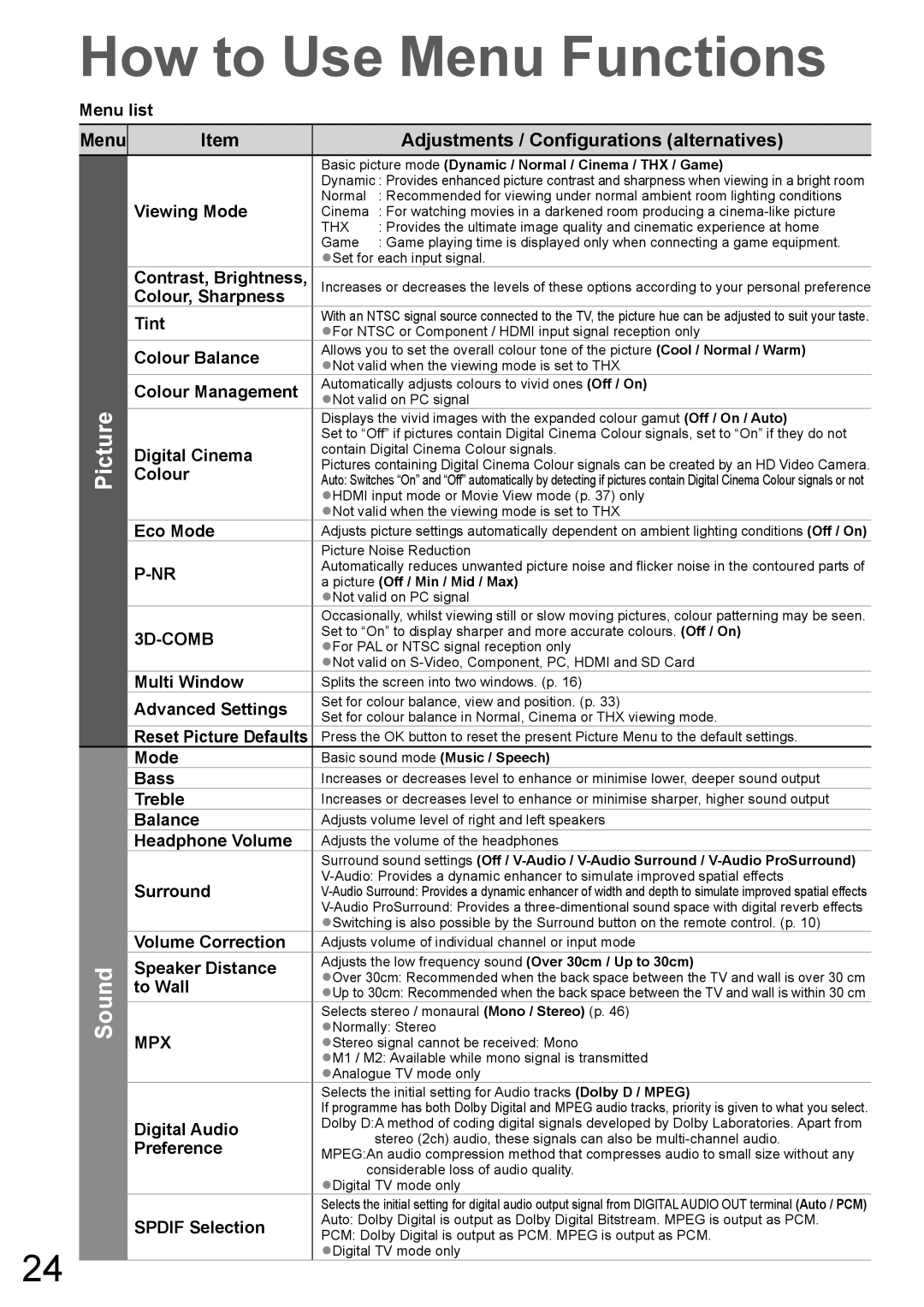
How to Use Menu Functions
Menu list
Menu | Item |
| Adjustments / Configurations (alternatives) |
|
| Basic picture mode (Dynamic / Normal / Cinema / THX / Game) | |
|
| Dynamic : Provides enhanced picture contrast and sharpness when viewing in a bright room | |
| Viewing Mode | Normal | : Recommended for viewing under normal ambient room lighting conditions |
| Cinema | : For watching movies in a darkened room producing a | |
|
| THX | : Provides the ultimate image quality and cinematic experience at home |
|
| Game | : Game playing time is displayed only when connecting a game equipment. |
|
| ●Set for each input signal. | |
Contrast, Brightness, Colour, Sharpness
Increases or decreases the levels of these options according to your personal preference
Picture
Sound
24
Tint | With an NTSC signal source connected to the TV, the picture hue can be adjusted to suit your taste. | |
●For NTSC or Component / HDMI input signal reception only | ||
Colour Balance | Allows you to set the overall colour tone of the picture (Cool / Normal / Warm) | |
●Not valid when the viewing mode is set to THX | ||
Colour Management | Automatically adjusts colours to vivid ones (Off / On) | |
●Not valid on PC signal | ||
| Displays the vivid images with the expanded colour gamut (Off / On / Auto) | |
| Set to “Off” if pictures contain Digital Cinema Colour signals, set to “On” if they do not | |
Digital Cinema | contain Digital Cinema Colour signals. | |
Colour | Pictures containing Digital Cinema Colour signals can be created by an HD Video Camera. | |
Auto: Switches “On” and “Off” automatically by detecting if pictures contain Digital Cinema Colour signals or not | ||
| ●HDMI input mode or Movie View mode (p. 37) only | |
| ●Not valid when the viewing mode is set to THX | |
Eco Mode | Adjusts picture settings automatically dependent on ambient lighting conditions (Off / On) | |
| Picture Noise Reduction | |
Automatically reduces unwanted picture noise and flicker noise in the contoured parts of | ||
a picture (Off / Min / Mid / Max) | ||
| ●Not valid on PC signal | |
| Occasionally, whilst viewing still or slow moving pictures, colour patterning may be seen. | |
| Set to “On” to display sharper and more accurate colours. (Off / On) | |
●For PAL or NTSC signal reception only | ||
| ●Not valid on | |
Multi Window | Splits the screen into two windows. (p. 16) | |
Advanced Settings | Set for colour balance, view and position. (p. 33) | |
Set for colour balance in Normal, Cinema or THX viewing mode. | ||
| ||
Reset Picture Defaults | Press the OK button to reset the present Picture Menu to the default settings. | |
Mode | Basic sound mode (Music / Speech) | |
Bass | Increases or decreases level to enhance or minimise lower, deeper sound output | |
Treble | Increases or decreases level to enhance or minimise sharper, higher sound output | |
Balance | Adjusts volume level of right and left speakers | |
Headphone Volume | Adjusts the volume of the headphones | |
| Surround sound settings (Off / | |
Surround | ||
| ||
| ●Switching is also possible by the Surround button on the remote control. (p. 10) | |
Volume Correction | Adjusts volume of individual channel or input mode | |
Speaker Distance | Adjusts the low frequency sound (Over 30cm / Up to 30cm) | |
to Wall | ●Over 30cm: Recommended when the back space between the TV and wall is over 30 cm | |
●Up to 30cm: Recommended when the back space between the TV and wall is within 30 cm | ||
| Selects stereo / monaural (Mono / Stereo) (p. 46) | |
MPX | ●Normally: Stereo | |
●Stereo signal cannot be received: Mono | ||
| ●M1 / M2: Available while mono signal is transmitted | |
| ●Analogue TV mode only | |
| Selects the initial setting for Audio tracks (Dolby D / MPEG) | |
| If programme has both Dolby Digital and MPEG audio tracks, priority is given to what you select. | |
Digital Audio | Dolby D:A method of coding digital signals developed by Dolby Laboratories. Apart from | |
Preference | stereo (2ch) audio, these signals can also be | |
MPEG:An audio compression method that compresses audio to small size without any | ||
| considerable loss of audio quality. | |
| ●Digital TV mode only | |
| Selects the initial setting for digital audio output signal from DIGITAL AUDIO OUT terminal (Auto / PCM) | |
SPDIF Selection | Auto: Dolby Digital is output as Dolby Digital Bitstream. MPEG is output as PCM. | |
PCM: Dolby Digital is output as PCM. MPEG is output as PCM. | ||
| ●Digital TV mode only |
